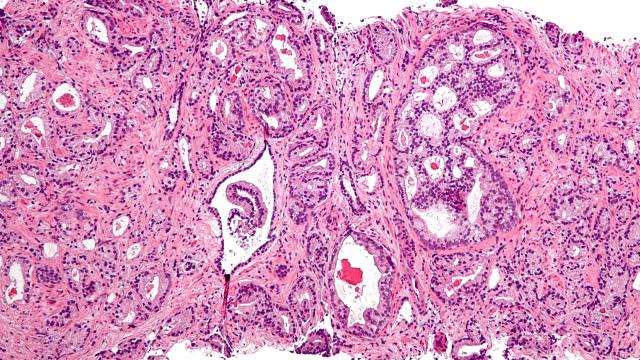A test developed by scientists in the UK and US might someday be able to pinpoint the men most likely to get prostate cancer. A new study published Monday in Nature Genetics suggests the test can detect the one per cent of men who are genetically most vulnerable to developing prostate cancer, a leading cause of cancer deaths among Australian men.
A micrograph of prostatic acinar adenocarcinoma, the most common form of prostate cancer. Image: Nephron (Wikimedia Commons)
The international research team used a new DNA analysis technique to peer into the genes of more than 70,000 people enrolled in previous studies. Some 45,000 of the subjects had already developed prostate cancer, while 25,000 hadn’t. So the researchers compared the two groups, singling out any inherited genetic variations that might have contributed to their cancer risk.
According to the authors, they managed to find 63 new variants never before associated with prostate cancer.
These results were then integrated with nearly a hundred genetic variants linked to prostate cancer previously found among 60,000 people to create a total genetic risk score. And finally, the researchers devised a test that uses a person’s saliva to detect these more than 150 variants.
“When you combine that score together, what you’re seeing is that individuals in the top one percentile have a six- to seven-fold higher risk of prostate cancer,” study author Fredrick Schumacher, an associate professor in the Department of Population & Quantitative Health Sciences at Case Western Reserve University, told Gizmodo. “So what this could help us do is come up with better screening rules.”
The Prostate Cancer Foundation of Australia recommends that men with a family history of prostate cancer should be screened for prostate cancer via the prostate-specific antigen (PSA) blood test every two years, beginning from age 40 to 45 depending upon their personal circumstances. Men at average risk should undergo testing every two years from age 50, and testing should cease at age 69, as the harm it may cause outweighs the benefits after age 70.
In the US, people over the age of 50 are generally screened for prostate cancer via the prostate-specific antigen (PSA) blood test. Those with a certain high level of PSA should be screened annually, while everyone else is advised to be screened every two years.
But the saliva test could reveal especially high-risk people who need annual screening regardless of their PSA level, while ruling out low-risk people who don’t need annual screening based on their genetic risk and PSA scores. Those people would only need screenings every two, five and maybe even 10 years, according to Schumacher.
Together, the variants seem to account for nearly 30 per cent of a person’s potential inherited risk of prostate cancer. Half of these high-risk men in the top one per cent might be expected to develop prostate cancer, compared to the one in every 11 men with an average level of genetic risk. The top 10 per cent have a risk 2.7 times higher, meaning as many as one in every four of these men could someday have prostate cancer.
For now, these numbers are only speculative. But some of the researchers are already planning to validate the test in the real world.
“If we can tell from testing DNA how likely it is that a man will develop prostate cancer, the next step is to see if we can use that information to help prevent the disease,” study author Ros Eeles, a professor of oncogenetics at The Institute of Cancer Research in the UK, said in a statement.
“We now hope to begin a small study in [primary care] practices to establish whether genetic testing using a simple spit test could select high-risk men who might benefit from interventions to identify the disease earlier or even reduce their risk.”
Because men in the US are already regularly screened for prostate cancer, the logistics of putting the saliva test through a trial are trickier, Schumacher said. US trials would probably need to take into account whether a man’s genetic risk score can lead to better outcomes in detecting or preventing prostate cancer in combination with his PSA score.
Since the newly published study included mostly men of European descent, they also need to find out how useful the risk score would be among men in other ethnic groups, particularly African American men, who are already more vulnerable to developing prostate cancer.
“We don’t want to put a trial out that’s just of white men,” Schumacher said. “We want to do something more comprehensive in the US.”
In addition to flagging the most at-risk men, this new list of genetic variants could be useful in efforts to prevent cancer from forming.
“The better understanding we have of the biology behind these risk scores, the more we can develop preventative treatments,” Schumacher said. The hypothetical drugs could be similar to those already in use for women at high risk of breast cancer.
